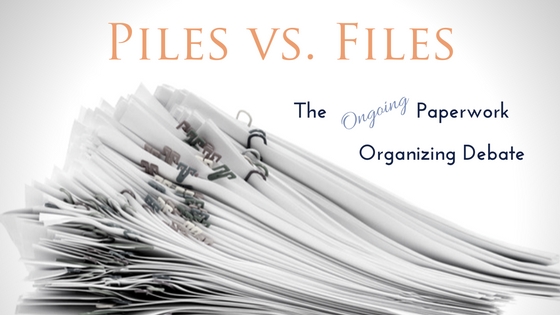Into every life a few piles will fall… or at least that’s how it seems for most people struggling with paper disorganization. When a few piles start becoming many, then you know that your systems for managing paperwork might be ready for a tune up.
A few years ago, I was giving a workshop for a private company and ended up in a side conversation with a member of the team about office disorganization. He told me that he would be too embarrassed to take me into his office since he had multiple piles of paperwork scattered around. Apparently, what I said next surprised him. “Having piles of paper on your desk doesn’t necessarily mean you’re disorganized. The question is whether there’s logic to the piles that allows you to find what you need easily.”
Apparently, that statement was what turned this particular guy around, and we even became friends afterward. As he told me later, my comment showed him that I wasn’t going to judge him or the situation on face value or have some harsh level of Type-A rigidity that required all surfaces to be free and clear to meet my standards of organized.
The reality is that the only difference between piles and files is that one lives horizontally on a surface and the other lives vertically in a drawer or other container. It may surprise you to discover that either can be well-organized or a completely disorganized disaster. Let me offer a few insights about paper organization that might help you recognize how to create the right system for you.
What Matters is the Logic
Whether your paper is collected into horizontal files on many surfaces or vertical files in a drawer is almost irrelevant compared to whether there is a clearly understandable logic of what to find where that can allow you to access the information you need quickly. However, I have seen some versions of “logic” that don’t sustain the test of time. In other words, the system falls apart quickly.
The biggest example I can name of flawed logic is organizing by recency. Have you even seen a situation in which someone is looking through a pile almost like an archaeological dig? The top most layers are the most recent additions and the stuff at the bottom is the oldest strata. At least until the pile topples over or you start digging through it and pull older stuff up to the top and start shuffling it around.
Bottom-line, this organizing approach is too prone to disaster. Whether that’s physical disaster of a toppled pile or mental disaster of a faulty memory. Organizing by recency is not an approach I would recommend.
It’s better to organize by topic or purpose. Pile or file, if everything in a specific grouping is related to the same project, then that’s a system that can be sustained. What most people forget is that paper organizing isn’t about storage, it’s about retrieval. How easily can you find what you need when you need it?
So, organizing all the items related to a particular project, topic, or action allows you to quickly and easily have relevant items at hand.
Archive vs. Active
Any paper organizing system can become clogged and unwieldy if years of archive files are cluttering up active spaces. In other words, whether you have piles or files, if the paperwork from your 1998 tax returns is still claiming space in your personal office and gathering dust or clogging a file drawer, then you’re making it harder to access and interact with the paperwork to which you actively want access now.
Those offices with piles stacked several feet high on every flat surface are usually suffering from this problem. Even if they are organized with logic by topic or project, it’s likely that there are many of those stacks that are no longer active and necessary for current activities, but would be better in well-labeled archive box in storage (or shredded/tossed in the trash).
Whereas, if you have a few piles or files around your office organized by topic that relate to active projects you’re interacting with daily or at least several times a week, then that sounds pretty well organized to me.
Piles vs. Files: The Final Showdown
If everything is sorted by project or topic and the archive stuff has been removed or relocated, then what really is the difference between a piled system and a filed system in terms of functionality? Honestly, it depends on the size of your office or space.
The best part about files is that they keep groups of like-information together, and if stored in drawers, crates, or boxes, they can be removed from your daily visual experience of your office. For many people that creates a greater sense of peace. However, for others the “hiddenness” of files creates an anxiety of “OOSOOM” [Out of Sight, Out of Mind.]
That’s why in addition to Active vs. Archive as a distinction in your paperwork, I often recommend that clients review their active papers and distinguish the active project files vs. the reference paperwork. Most of us have a fair amount of “reference only” paperwork that comes in through the mail box. Bank statements, investment statements, bills (after they’re paid), etc. These are docs that are important to keep around for the sake of taxes, budgeting, and to reference if we need to call the electric company and find our account number.
However, other than certain specific, unusual circumstances, we aren’t frequently interacting with these documents once they’re filed. Since we do access them, and get new ones each month, they are active, but they are still occasional reference rather than our active project files that we use daily or weekly to get things done.
So, if you feel like the idea of getting rid of your piles entirely due to “OOSOOM” is frightening, then how about a first step. What if you just file the reference papers (according to topic), and create clear piles for each of your active projects?
Then, the only paper that’s out is the stuff that is most vibrantly active in your life. Everything else finds a filed home according to the frequency of your use either in the file drawer in your office or an archive box in storage.
Here’s my big confession, even after over 13 years in the organizing and productivity industry, until very recently if you walked into my office, you would still have found a pile on my desk. However, just a few weeks ago, I was finally able to go through that lingering pile (maybe an inch high) and recognize that it really wasn’t serving me. I scanned some stuff into Evernote, filed a few things, and recycled most of it.
I realized that my workflow has finally become so digitally-oriented that having the papers in a pile wasn’t helping it stay top of mind. Rather, anything except what was on the top of the stack was buried and hidden away. So, actions got added to my Master List (not many, just a few), and the pile quickly disappeared.
Can I say that I will never again use piles? No, I’m not that naive. However, when they do appear, then using the approach above I know that they will be effective and well-organized.
Next Steps
If you look around your office and see a bunch of paperwork scattered or piled, then pause for a moment and consider these questions:
1) Can you find what you want in less than a minute? – If it’s longer, then time for a tune up.
2) Are there piles (or files in your drawers) that haven’t been accessed in the last year? – If the answer is yes, then time for a tune up.
3) Are you organizing by recency or by topic/project? – If you’ve been organizing by recency, then time for a tune up.
Fighting to find what you need is a lot of wasted energy, time, and effort. Give yourself a gift of creating a paper organizing system that works well for you. And, if you love your piles, then keep them organized and pile away!



